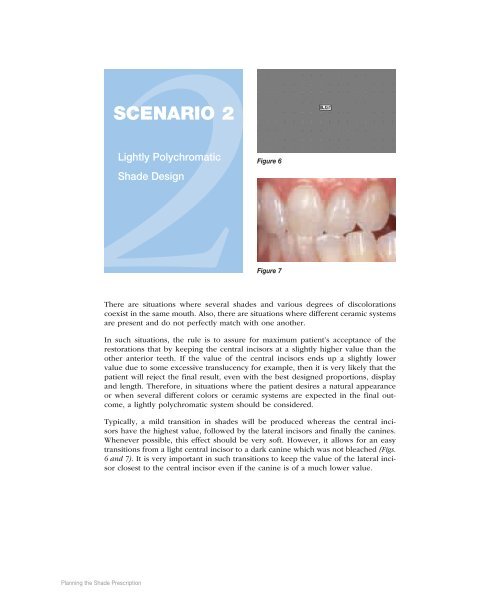Chairside Magazine Volume 2, Issue 1 - Glidewell Dental Labs
Chairside Magazine Volume 2, Issue 1 - Glidewell Dental Labs
Chairside Magazine Volume 2, Issue 1 - Glidewell Dental Labs
You also want an ePaper? Increase the reach of your titles
YUMPU automatically turns print PDFs into web optimized ePapers that Google loves.
2SCENARIO 2<br />
Lightly Polychromatic<br />
Shade Design<br />
Figure 6<br />
Figure 7<br />
SCENARIO 3<br />
Lightly Monochromatic<br />
Shade Design with<br />
Effects<br />
Figure 8<br />
Figure 9<br />
There are situations where several shades and various degrees of discolorations<br />
coexist in the same mouth. Also, there are situations where different ceramic systems<br />
are present and do not perfectly match with one another.<br />
In such situations, the rule is to assure for maximum patient’s acceptance of the<br />
restorations that by keeping the central incisors at a slightly higher value than the<br />
other anterior teeth. If the value of the central incisors ends up a slightly lower<br />
value due to some excessive translucency for example, then it is very likely that the<br />
patient will reject the final result, even with the best designed proportions, display<br />
and length. Therefore, in situations where the patient desires a natural appearance<br />
or when several different colors or ceramic systems are expected in the final outcome,<br />
a lightly polychromatic system should be considered.<br />
Typically, a mild transition in shades will be produced whereas the central incisors<br />
have the highest value, followed by the lateral incisors and finally the canines.<br />
Whenever possible, this effect should be very soft. However, it allows for an easy<br />
transitions from a light central incisor to a dark canine which was not bleached (Figs.<br />
6 and 7). It is very important in such transitions to keep the value of the lateral incisor<br />
closest to the central incisor even if the canine is of a much lower value.<br />
The typical incisal effects found on unworn incisors include: 1. Halo effect;<br />
2. Transparent incisal Border; 3. Dentin Streaks or mamelons; and 4. Proximal<br />
translucency (Figs. 8 & 9). These are the typical shading effects young unworn<br />
incisors have, imparting a very pleasing effect to the tooth shade overall. The<br />
incorporation of these effects for the natural-driven patients yields the above shade<br />
prescription. It is recommended that the clinician provides in such situations the<br />
same template each time so that nuances and variations recorded from patient to<br />
patient may be more easily interpreted.<br />
Fig. 2, 3, 6, 7, 8, and 9 are reproduced from the textbook by Chiche G., Aoshima H.: Smile Design. Quintessence Pub.<br />
Co. Inc. Chicago 2005.<br />
REFERENCES<br />
1. Mc Lean, JW.: The Science and Art of <strong>Dental</strong> Ceramics. Louisiana State University School of Dentistry, Monographs<br />
I and II, (1974) III and IV (1976)<br />
2. McLean JW.: The science and art of dental ceramics. Quintessence Pub. Co. Inc. Chicago 1980.<br />
3. Sproull R.C.: Color matching in dentistry. Practical applications of the organization of color. J. Prosthet. Dent.<br />
29:556;1973.<br />
4. Jinoian V.: The importance of proper light source in metal Ceramics. In: Preston J.D.: Perspectives in <strong>Dental</strong> ceramics.<br />
Proceedings of the Fourth International Symposium on Ceramics. pp 229. Quintessence Pub. Co. Inc. 1988,<br />
Chicago.<br />
5. Hegenbarth E.A.: The Creative Color System. Quintessence Pub. Co. Inc. 1989, Chicago.<br />
6. Miller L.L.: Scientific approach to shade matching. In: Preston J.D.: Perspectives in <strong>Dental</strong> ceramics. Proceedings<br />
of the Fourth International Symposium on Ceramics. pp 193. Quintessence Pub. Co. Inc. 1988, Chicago.<br />
7. Nakagawa Y. at al.: Analysis of natural tooth color. Shikai Tenbo 46;527;1975<br />
8. Sekine M. et al.: Translucent effects of porcelain jacket crowns. 1. Study of translucent patterns in the natural teeth.<br />
Shika Giko 3:49;1975.<br />
9. Chiche G., Pinault A.: Esthetics of Anterior Fixed Restorations. Quintessence Pub. Co. Inc. Chicago 1994.<br />
10. Chiche G., Aoshima H..: Smile Design. Quintessence Pub. Co. Inc. Chicago 2005. Consultant Noritake co.<br />
Planning the Shade Prescription<br />
Planning the Shade Prescription
















